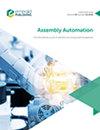Model predictive control of direct-driven surface-mounted permanent magnet synchronous generator based on active disturbance rejection controller
IF 1.7
4区 计算机科学
Q3 AUTOMATION & CONTROL SYSTEMS
引用次数: 3
Abstract
Purpose This paper aims to mainly discuss how to suppress the disturbances accurately and effectively in the wind energy conversion system (WECS) of the direct drive surface mount permanent magnet synchronous generator (SPMSG). Design/methodology/approach The disturbances in wind energy conversion system have seriously negative influence on the maximum power tracking performance. Therefore, a model predictive control (MPC) method of model compensation active disturbance rejection control (ADRC) strategy in parallel connection is designed, which optimizes the speed tracking performance compared with the existing control strategy of MPC and ADRC in series connection. Based on the traditional ADRC, a multi parameter model compensation ADRC strategy is added to better estimate the disturbances. At the same time, a torque feedback strategy is added to compensate the disturbances caused by load torque and further optimize the speed loop tracking performance. Findings The simulation results show that the designed control method has advantages than the traditional control method in compensating the disturbances and tracking the maximum power more effectively. Originality/value The simulation results show that the designed control method is superior to the traditional proportional control method, which can better compensate the internal and external disturbances and track the maximum power more effectively.基于自抗扰控制器的直接驱动面装永磁同步发电机模型预测控制
目的本文主要讨论直接驱动表面安装永磁同步发电机(SPMSG)风能转换系统(WECS)中如何准确有效地抑制扰动。设计/方法/途径风能转换系统中的扰动对最大功率跟踪性能有严重的负面影响。因此,设计了一种并联模式补偿自抗扰控制(ADRC)策略的模型预测控制(MPC)方法,与现有的MPC和ADRC串联控制策略相比,该方法优化了速度跟踪性能。在传统自抗扰控制器的基础上,增加了多参数模型补偿自抗扰策略,以更好地估计扰动。同时,增加了转矩反馈策略,以补偿负载转矩引起的扰动,并进一步优化速度环路跟踪性能。仿真结果表明,与传统控制方法相比,所设计的控制方法在更有效地补偿扰动和跟踪最大功率方面具有优势。原创性/价值仿真结果表明,所设计的控制方法优于传统的比例控制方法,能够更好地补偿内部和外部扰动,更有效地跟踪最大功率。
本文章由计算机程序翻译,如有差异,请以英文原文为准。
求助全文
约1分钟内获得全文
求助全文
来源期刊

Assembly Automation
工程技术-工程:制造
CiteScore
4.30
自引率
14.30%
发文量
51
审稿时长
3.3 months
期刊介绍:
Assembly Automation publishes peer reviewed research articles, technology reviews and specially commissioned case studies. Each issue includes high quality content covering all aspects of assembly technology and automation, and reflecting the most interesting and strategically important research and development activities from around the world. Because of this, readers can stay at the very forefront of industry developments.
All research articles undergo rigorous double-blind peer review, and the journal’s policy of not publishing work that has only been tested in simulation means that only the very best and most practical research articles are included. This ensures that the material that is published has real relevance and value for commercial manufacturing and research organizations.
 求助内容:
求助内容: 应助结果提醒方式:
应助结果提醒方式:


